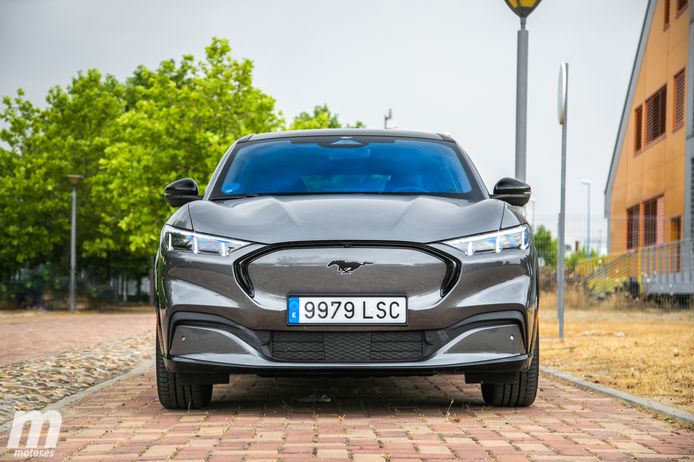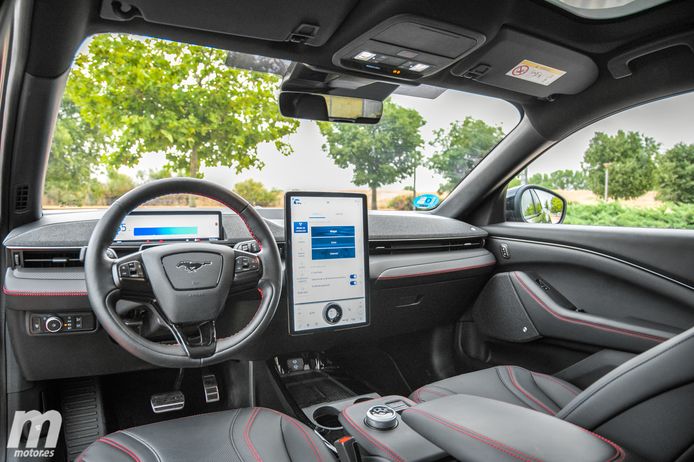Is the WLTP homologation of the electric Ford Mustang Mach-E true? We have conducted a test drive on the AWD variant with Extended Range battery, which officially has 540 km of autonomy. Will be real? We measure it in normal driving and on different types of road.
The Ford Mustang Mach-E has become on its own merits one of the best alternatives on the current electric car market. Its stylized aesthetic line, its practicality and, above all, its specifications have made this a seductive of the staunchest lovers of practical and sports electrification. Declaring itself as a competitor for the Tesla Model Y, the Mustang presents more distinctive and particular features but, Will it be able to lower the consumption figures approved by the Elon Musk model?
Of course this data will depend at all times on the motorization that our model is equipped with but, more importantly, it is the driving that we carry out on the car, since the data may vary significantly in one case or another. Our small consumption test has been carried out aboard a Ford Mustang Mach-E with all-wheel drive AWD and the extended-range battery, which has a gross capacity of 99 kWh. According to the officially homologated data for this specific model and variant, its average combined energy consumption is 18.7 kWh/100km. We have tested whether this data is reliable or if, on the contrary, it is far from reality.
Alternatives in the range
In addition to the engine used by our unit, the Ford Mustang Mach-E catalog presents other highly recommended alternatives to suit the taste and needs of the customer. also exists a Standard Range battery alternative with a gross capacity of 76 kWh for the all-wheel drive variant that is presented as the most recommended models in the range.
In addition to these,Ford also has a rear-wheel drive access variant. which, in turn, also has the possibility of installing the same two types of battery mentioned above: Standard Range and Extended Range. This entry-level model to the range focuses its benefits on providing its customer with a model with greater autonomy being able to exceed 600 km of range, as well as presenting the lowest approved energy consumption, just 16.5 kWh/100 km.
Finally and as the head of the list, Ford presents the GT variant. This will always have all-wheel drive and will only have the highest capacity battery (Extended Range). However, this will be the most “greedy” model of all, since its high power and its sportier specifications make it the variant that most frequently asks to be plugged in. In this case, the average consumption approved in the WLTP cycle is 20.7 kWh/100 km. As can be verified, the range of the Ford Mustang Mach-E there is for all tastes, but is it possible to make really low consumption in this car? We check it.

Start of the test
According to official data approved by Ford, the unit that we have in hand and with which we will carry out this test, is capable of traveling up to 540 kilometers on a single charge. With the battery charged to 100% of its capacity, the small panel of the digital instrumentation of the electric car shows us a maximum autonomy of 450 kilometers, that is, 90 kilometers below what is approved. However, this is not a piece of information that we should resort to concisely because this figure will vary depending on the driving we do and, therefore, on the general average consumption that we mark on the meter.
Precisely for this reason, once we start, we travel approximately 25 kilometers being quite careful with the accelerator pedal, although with the air conditioning connected. During this short and brief journey, our meter shows a consumption of just 8 kWh/100km, which detonates directly after said route has elapsed, the total range meter now marks 470 kilometers. Has risen! And that is precisely due to the type of driving performed on it.
Our test unit homologates 540 kilometers of autonomy. Will he be able to fulfill what he promised?
The Ford Mustang Mach-E is an electric car that allows you to play a lot with driving, presenting different energy recovery modes. In the first place, in the gear selector itself we will find an “L” button with which when releasing the accelerator it will create a small braking with which will regenerate a certain amount of electricity; As an alternative, within the main menu of the vehicle, on the central infotainment screen, we will find the option to activate the E-One Pedal, with which we can even brake the vehicle completely by simply releasing the accelerator. This mechanism is really comfortable in urban areas.
We were already able to test the Ford Mustang Mach-E on video
Knowing how to combine the use of these two elements (or the absence of both), we can achieve much lower energy consumption. For the urban environment it will always be recommended to activate the E-One Pedalwhile driving on the motorway, it is best to deactivate this, as well as the L mode so that the vehicle can coast for a longer distance without braking and at an energy consumption of 0 kWh/100km, as happens in the thermal vehicles with what is known as “sail mode”.
Making use of these tools in the city, the consumption could be around 13 kWh/100km in ideal conditions (light traffic and not many stops and starts at traffic lights) and with the air conditioning on. At the moment in which we deactivate the air conditioning, the cost may be even lower. In the completely opposite case to the one presented, in which we run into a traffic jam and have the air conditioning activated, its average will rise quickly to 23 kWh/100km. An average well above what is presented for ideal conditions and for which many firms boast of their approvals; remember, these measurements will always be made under ideal conditions.
In a highway or expressway environment, the Mustang Mach-E continues to behave splendidly and at a speed of 115 – 120 km/h, with the air conditioning activated and the hold modes completely deactivated, its consumption will be below 18 kWh/100km without even blinking. This means that, doing some quick and simple calculations, if we maintain a constant rate of consumption, the actual autonomy can be about 500 kilometers in this environmenta figure very close to the 540 km that the model promises according to its WLPT homologation in mixed cycle.

But as a good Mustang that it is, the model has sports capabilities that we should not be left with the desire to squeeze thoroughly, but always bearing in mind that indulging in a twisty mountainous road will carry out a higher energy consumption, logically. With the Untamed mode activated (better known as “Sport Mode”), air conditioning activated and unleashing all its horses, the American electric model’s energy consumption will be above 32 kWh/100km, which means almost twice the expense than in the cheapest possible mode. But since this is something that we will do once in a while, it will not be something that you should worry about concisely.
In all the time that this test lasted, the Ford Mustang Mach-E scored a total average of 17.8 kWh/100kmwhich is a more than deserved outstanding for the model, since this average was the total after traveling almost 500 kilometers (not uninterrupted) with the car, including urban and extra-urban driving, acceleration, etc… Even so, this average obtained is 0.9 below what is approved in the WLTP cycle.so we can officially say that the Mustang Mach-E is one of the best alternatives on the current electric market for anyone looking for energy savings.


